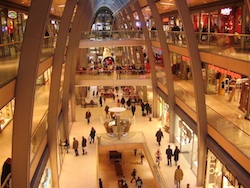
In the past few years, there has been a huge change in the way we shop. In the old days shopping used to mean a trip to the High Street, now we are much more likely to turn the PC on and browse (and purchase) online.
Online shopping has had a particularly dramatic impact in the UK. Here, internet retailing in 2012 totalled €43 bn, with the nearest European competitor, Germany, only managing €25 bn. In Europe as a whole, the average per country for internet spending was only €5 bn.
And the huge growth in online retailing has caused a major rethink in the way the High Street supply chain works which, in turn, is having a major effect on the property requirements of the retail sector.
For one thing, the old supply chain model was predominantly set up to service High Street stores, but one effect of online retailing has been to add a huge amount of additional shelf space to our retailers’ offer. More products and more variety mean more warehouse space is needed to stock these items.
At the same time, retailers are grappling with the issue of how to manage the process of getting an order placed on the Internet delivered to a customer as seamlessly as possible, something the existing supply chain is not equipped to do, particularly the last leg of the journey, which is from the warehouse to the customer.
Cushman & Wakefield, has just produced a report into the growth of e-commerce and trends in retailing, and has found that there is a requirement for more strategically located purpose-built warehouses, and the creation of smaller buildings close to large conurbations, with the aim of facilitating ‘same day’ deliveries.
This has been spurred on further by the move by some High Street chains, such as Argos and John Lewis, towards embracing the ‘click and collect’ model, where shoppers buy online and then travel to their nearest shop to pick up their goods.
Argos now receives 43 per cent of its sales online, and John Lewis 25 per cent. The impact of this has not been to decimate the High Street, as outlets are still needed to act as collection points.
In fact, the phenomena has led to the emergence of a trend known as omni channels, where physical stores and online platforms are becoming more integrated, rather than left to operate as separate channels.
One result of this – as well as the need to cater for the additional online shelf space - has been the need for the mega warehouses to stock products. Among recent examples are M&S's 950,000 sq ft premises at Castle Donington, and John Lewis’s 670,000 sq ft site at Milton Keynes.
The impact of the current pattern of retailing is not restricted to retailers – there has also been huge growth in the parcel distribution sector, for example Royal Mail’s recent acquisition of 750,000 sq ft of space across the country, Direct Parcel Distribution taking up a further 390,000 sq ft (including a 300, 000 sq ft warehouse at Hinckley) and Hermes taking 250,000 of space in Tamworth.
This has led to significant levels of activity in the warehousing and distribution market, where there is now a shortage of existing buildings. Developers such as IM Properties have already indicated that they are set to turn to speculative development to meet demand, the first of which is Birch Coppice at Tamworth.
Other specialist shed developers may follow suit. At the same time, there is evidence of growth in the build to suit market. Because of the shortage of suitable buildings, many occupiers are considering bespoke developments, in order to meet their requirements.
This is particularly true of the smaller urban distribution warehouses and e-fulfilment centres needed for the edge of the conurbations, which is the reversal of the trend employed in recent years, namely to focus on large regional or national distribution centres, the aim of which was to drive down costs.
A good example of the specialist buildings needed these days is provided by the grocery sector, whose online activities have led to the need for dark stores. These are warehouses laid out to resemble supermarkets, where the in-house workforce puts together orders placed online, which are then delivered to customers.
There are other trends that are only just emerging, such as locker space, which is where goods are left for customers at certain public places, such as railway stations. These developments will certainly further fuel the need for a network of urban distribution centres.
There is no doubt that the consumers of today are demanding seamless shopping experiences, where accessibility of product and ease of purchases are key. In order to meet that expectation, retailers and developers must rethink the supply chain and upgrade it.
There is plenty of evidence that this is already happening, but the process will be a lengthy and challenging one.
About the author
 David Binks is industrial partner at real estate company Cushman & Wakefield’s Birmingham office.
David Binks is industrial partner at real estate company Cushman & Wakefield’s Birmingham office.
Have you any commercial property events you'd like to tell us about? It could be networking, exhibitions, seminars, industry lunches or sporting fixtures. We will list them for free. Just email newsdesk@propnews.co.uk with the following details: Event name, date, time, venue, cost, booking info and a brief description of the event.
To list your property job vacancies on Property News. Email: richenda@propnews.co.uk.